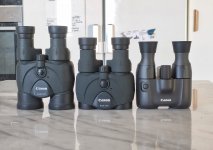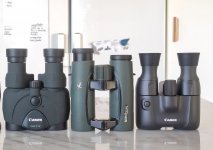@kabsetz After looking at the 8x20, I would have somehow assumed that the 10x32 would share some of its improvements over the previous generation. So, without having ever looked through them (maybe wishful thinking), I thought they would have a considerably less amount of CA than my 12x36 IS III because:
Hence my expectation. Have you used the 12x36 IS III in the past and are able to comment on the 10x32 regarding this? It's truly a pity that the 8x20 work so well in sharpness/contrast/CA (so that the image is way less soft than in the 12x36) but the 10x32 can't take advantage of those improvements. I remember reading Roger Vine's review of the 14x32, and his disappointment, but I would be inclined to think that some of what Vine experienced could be avoided by choosing 10x instead of 14x.
- They're newer, and the 8x20 do it so well (yes, they're 8x, but also cheaper).
- They're only 10x, compared to my 12x36.
Hence my expectation. Have you used the 12x36 IS III in the past and are able to comment on the 10x32 regarding this? It's truly a pity that the 8x20 work so well in sharpness/contrast/CA (so that the image is way less soft than in the 12x36) but the 10x32 can't take advantage of those improvements. I remember reading Roger Vine's review of the 14x32, and his disappointment, but I would be inclined to think that some of what Vine experienced could be avoided by choosing 10x instead of 14x.








